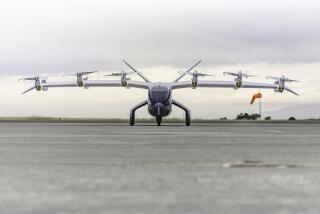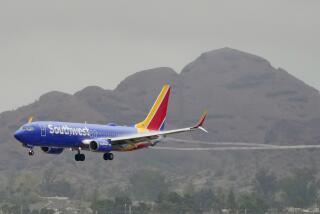Airlines’ Latest Battle: L.A. to New York Nonstop
It used to be that flying nonstop from Los Angeles to major East Coast cities meant having only a handful of airline options and forking over a bundle for a seat. But as Dennis Bonilla can tell you, that’s history.
Bonilla, president of a Culver City medical education firm called Medsn Inc., flies America West, a discount carrier that elbowed into the nonstop Los Angeles-to-New York market last fall with low fares and few restrictions.
“I used to take United and American to New York,” Bonilla said recently as he waited to board at Los Angeles International Airport. Then, after America West rolled out its service, “I jumped right on it.” By booking 14 days in advance, he said, “it’s $200 round trip.”
The competition for cross-country fliers has erupted into a wide-open dogfight. Once largely the domain of the big three U.S. carriers -- AMR Corp.’s American, UAL Corp.’s United and Delta Air Lines -- the nonstop transcontinental market is flooded with offerings from aggressive rivals.
They include not only America West, a unit of America West Holdings Corp. of Phoenix, but also AirTran Airways, owned by AirTran Holdings Inc.; Alaska Airlines, part of Alaska Air Group Inc.; JetBlue Airways; Southwest Airlines; and Frontier Airlines.
In the last several months, all have added nonstop flights or jumped into the “transcon” market with cheap-fare promotions aimed at building customer loyalty. Depending on the airline, the flights are connecting the California cities of Los Angeles, San Francisco, Long Beach, San Jose and Sacramento with New York, Boston, Washington, Philadelphia, Baltimore and Atlanta on the East.
In response, American, United and Delta have added transcon flights and initiated fare cuts of their own.
“We’ve made the decision to stand and fight,” AMR Chief Executive Gerard Arpey told analysts recently. “Those are markets we’ve been in forever.”
The result is a boon for Californians, who are enjoying plummeting fares and a broad array of choices as the busy summer travel season approaches. Discount airlines carry more than 25% of passengers traveling coast to coast, analysts estimate, and that number is expected to keep rising.
Last May, there were about 150 daily transcon round trips from various airports, airline analyst Sam Buttrick of investment firm UBS noted in a recent report. This May, there are more than 200.
The transcon battle rages as the airline industry is slowly recovering from a deep, three-year slump that staggered carriers with billions of dollars in losses. With travel picking up from its post-Sept. 11 downturn and the economy improving, flights are being added nationwide. American, United and Delta are narrowing their losses, though United remains in Chapter 11 bankruptcy proceedings.
For all carriers, the crowded transcon market is problematic. They say their “yields,” or average ticket prices, have dropped sharply in the last 12 months because of price cutting.
Even profitable airlines such as America West and AirTran concede that they are losing money on their new transcon routes. Both vow to keep flying them, however, predicting that the market eventually will shake out and that they will be among the survivors because of their low operating costs.
The bigger airlines are “trying to drive us out” by adding flights and cutting fares, but “we’re not going to leave,” America West Chief Executive W. Douglas Parker told analysts recently. “The efficient provider is not the one going away.”
Robert Fornaro, AirTran’s president and chief operating officer, said the airline expected that it wouldn’t make money on its Los Angeles-to-Atlanta route for two years. Still, he said, AirTran can afford to be patient.
“As long as you have a profitable base” of business, Fornaro said, “you can compete and take what the other guys throw at you.”
And right now that means old-fashioned fare wars.
JetBlue is offering $99 one-way fares from its West Coast base in Long Beach to New York, Washington and Boston. United is selling $99 one-way fares through Monday to promote its new service between Sacramento and Washington/Dulles starting June 3. Alaska Airlines, which is launching service from LAX to Washington’s Reagan National Airport on June 7, has an introductory one-way fare of $89 through June 30. All carry various restrictions.
“It’s really cheap,” said Cindy Bailey of Calabasas, another traveler who was waiting for America West’s flight from LAX to New York. In addition to the price, she likes the flight’s early-morning departure and nonstop service. “Usually you don’t get all three” of those features, she said.
As for business fliers like Bonilla, they are no longer willing to pay walk-up transcon fares of $1,000 or more. He and other road warriors are mimicking leisure travelers by booking further in advance and scouring the Internet to lock in lower rates.
So the big carriers have little choice but to match the smaller airlines’ price cuts. Before America West entered the Los Angeles-to-New York market, American Airlines’ one-way unrestricted fare -- the ticket often favored by business fliers who book flights on short notice -- had been stuck at more than $1,100 for two years. Since America West moved in, American’s fare has tumbled to $599, according to Harrell Associates, an industry consulting firm that tracks fare data.
America West’s move “was the tipping point in setting off” the rush by others to add nonstop transcon flights, said Prashanth Kuchibhotla, senior airline analyst at EClipse Advisors, a travel consulting firm in Philadelphia. It exposed how the big airlines, by having such high fares, “left themselves open for attack underneath.”
Cross-country flying has been cut-rate before. The now-defunct People Express and other carriers introduced the concept in the early 1980s, flying dated jumbo jets that were cheap to buy but costly to operate. Their service and on-time performance were often subpar.
Airlines such as America West and Southwest initially avoided nonstop transcon service. They made money flying busy short-haul routes with smaller jets; they could fly you across the country only if you were willing to make at least one stop on the way.
Thanks to advances in aircraft technology, these carriers, led by Southwest, now pilot young fleets of efficient jetliners that can easily fly from Los Angeles to New York.
“A lot of this started when the narrow-body airplanes that were mainly used to bop around 300-mile routes began to increase their range,” said Robert Harrell, president of Harrell Associates.
Southwest, for example, has steadily expanded from its short-haul niche to long- distance flights, and now it flies nonstop from Los Angeles to Baltimore/Washington International Airport. Its unrestricted one-way fare: $299.
Although they can’t always post the lowest fares on trans-con flights, American and the other majors offer connecting routes that span the globe, long-standing frequent-flier programs and many more daily flights than most of the new entrants. Those assets can breed loyalty among travelers willing to forgo the absolute cheapest fare.
Frequent flights to the same city remain especially important to business travelers, who want the flexibility to catch a later flight if a meeting runs long, said United Chief Executive Glenn Tilton. As long as United offers “fair value for the money,” that’s a customer United can keep, he said.
“We’re not going to compete on price alone,” Tilton added.
Indeed, American plans to raise its number of daily Los Angeles-to-New York flights to 12 from 10 starting June 10, by eliminating two New York-bound flights at John Wayne Airport in Orange County.
But the big airlines also must keep slashing their costs, or using their people and airplanes more productively, if they want to stay competitive on fares and still make money on transcon routes and everywhere else, industry executives say.
In the meantime, Californians and other passengers will keep enjoying relatively low fares when they fly across the country, because the discount carriers won’t disappear from the scene anytime soon, analysts predict.
Said Kuchibhotla of EClipse Advisors: “They’re in it for the long haul.”
*
(BEGIN TEXT OF INFOBOX)
The long haul
The transcontinental market, once reserved for a few giant airlines, is now a crowded field with smaller discount carriers adding flights and the larger airlines retaliating with more flights of their own -- all of which is driving down fares. Here are some of the newer flights:
*--* Airline Route AirTran Los Angeles-Atlanta Alaska Los Angeles-Washington/Reagan (starts June 7) American Los Angeles-New York (12th daily flight starts June 10) San Francisco-New York (5 daily flights) America West Los Angeles-New York Los Angeles-Boston Los Angeles-Washington/Dulles (starts June 1) Delta/Song Los Angeles-Orlando, Fla. Los Angeles-Tampa, Fla. Frontier Los Angeles-Philadelphia (starts May 23) JetBlue Long Beach-Boston Sacramento-Washington/Dulles San Jose-New York (starts June 10) Southwest Los Angeles-Baltimore/Washington United Sacramento-Washington/Dulles (starts June 3) Los Angeles-New York (7th daily flight starts June 3)
*--*
Source: The airlines
More to Read
Sign up for The Wild
We’ll help you find the best places to hike, bike and run, as well as the perfect silent spots for meditation and yoga.
You may occasionally receive promotional content from the Los Angeles Times.







